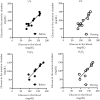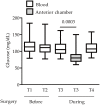Glucose levels between the anterior chamber of the eye and blood are correlated based on blood glucose dynamics
- PMID: 34469502
- PMCID: PMC8409619
- DOI: 10.1371/journal.pone.0256986
Glucose levels between the anterior chamber of the eye and blood are correlated based on blood glucose dynamics
Abstract
Glycemic control is essential to manage metabolic diseases such as diabetes. Frequent measurements of systemic glucose levels with prompt managements can prevent organ damages. The eye is a glucose highly demanding organ in our body, and the anterior chamber (AC) in the eye has been suggested for a noninvasive blood glucose monitoring site. However, calculating blood glucose levels from measuring glucose levels in AC has been difficult and unclear. In this study, we aimed to examine glucose levels from AC and find a correlation with blood glucose levels. A total of 30 patients with cataracts (men and women, study 1; 7 and 3, study 2; 9 and 11) who visited Keio University Hospital from 2015 to 2018 and agreed to participate in this study were recruited. Glucose levels from AC and the blood were examined by a UV-hexokinase or H2O2-electrode method before/during the cataract surgery. These values were analyzed with regression analyses depending on the groups (blood glucose-ascending and descending groups). In the blood glucose-descending group, glucose levels from AC were strongly correlated with blood glucose levels (a high R2 value, 0.8636). However, the relatively moderate correlation was seen in the blood glucose-ascending group (a low R2 value, 0.5228). Taken together, we showed different correlation ratios on glucose levels between AC and the blood, based on blood glucose dynamics. Stacking data regarding this issue would enable establishing noninvasive blood glucose monitoring from measuring glucose levels in AC more correctly, which will be helpful for proper and prompt managements for glucose-mediated complications.
Conflict of interest statement
The authors have declared that no competing interests exist.
Figures





References
-
- Erlich DR, Slawson DC, Shaughnessy AF. “Lending a hand” to patients with type 2 diabetes: a simple way to communicate treatment goals. American family physician. 2014;89(4):256, 8. Epub 2014/04/04. . - PubMed
-
- Group DCaCTR. Effect of intensive diabetes treatment on the development and progression of long-term complications in adolescents with insulin-dependent diabetes mellitus: Diabetes Control and Complications Trial. The Journal of Pediatrics. 1994;125(2):177–88. doi: 10.1016/s0022-3476(94)70190-3 - DOI - PubMed
Publication types
MeSH terms
Substances
LinkOut - more resources
Full Text Sources
Medical

